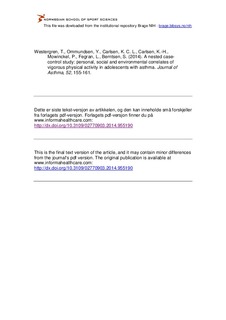| dc.contributor.author | Ommundsen, Yngvar | |
| dc.contributor.author | Carlsen, Karin C. Lødrup | |
| dc.contributor.author | Westergren, Thomas | |
| dc.contributor.author | Carlsen, Kai-Håkon | |
| dc.contributor.author | Mowinckel, Petter | |
| dc.contributor.author | Fegran, Liv | |
| dc.contributor.author | Berntsen, Sveinung | |
| dc.date.accessioned | 2016-02-02T10:32:08Z | |
| dc.date.available | 2016-02-02T10:32:08Z | |
| dc.date.issued | 2014-08-29 | |
| dc.identifier.citation | Journal of Asthma. 2014, 52, 155-161 | nb_NO |
| dc.identifier.uri | http://hdl.handle.net/11250/2375662 | |
| dc.description | I Brage finner du siste tekst-versjon av artikkelen, og den kan inneholde ubetydelige forskjeller fra forlagets pdf-versjon. Forlagets pdf-versjon finner du på http://www.tandfonline.com/doi/full/10.3109/02770903.2014.955190 / In Brage you'll find the final text version of the article, and it may contain insignificant differences from the journal's pdf version. The definitive version is available at http://www.tandfonline.com/doi/full/10.3109/02770903.2014.955190 | nb_NO |
| dc.description.abstract | Objective: Physical activity (PA) is associated with health benefits. Children and adolescents with asthma may be limited in their PA, particularly at vigorous intensity due to asthma symptoms or poor psychological adjustment to asthma. We aimed to investigate if self-perceived competence, enjoyment, support from others and social-physical environment were associated with vigorous physical activity (VPA) and secondarily to assess if such associations were modified by asthma and asthma severity. Methods: Data from a nested case–control study at 13 years of age within the birth-cohort Environment and Childhood Asthma Study were compiled from 95 participants with and 79 without asthma. The participants completed a questionnaire designed to capture self-perceived competence, enjoyment, support from others and social-physical environment. VPA, defined as ≥ 6 Metabolic Equivalents, was recorded objectively by SenseWear™ Pro2 Armband. Asthma severity was assessed pragmatically by lung function and use of inhaled glucocorticosteroids and β2-agonists and incidence of exacerbations in the last 14 days. Data were analysed using linear regression analysis. Results: No significant differences between adolescents with and without asthma were identified in terms of VPA, competence-enjoyment, support from others and social-physical environment. Peer support (b = 0.29 (0.05–0.52)) and competence-enjoyment (b = 0.23 (0.01–0.44)) were significantly and positively associated with VPA, and teacher support (b = –0.26 (−0.50 to −0.02)) were inversely associated. The model explained 25% of the variance in VPA. Conclusions: Peer support and competence-enjoyment were positively associated with increased VPN in adolescents irrespectively of asthma and asthma severity. | nb_NO |
| dc.language.iso | eng | nb_NO |
| dc.publisher | Taylor & Francis | nb_NO |
| dc.subject | social support | nb_NO |
| dc.subject | social environment | nb_NO |
| dc.subject | competence | nb_NO |
| dc.subject | phychological adjustment | nb_NO |
| dc.subject | health benefits | nb_NO |
| dc.title | A nested case-control study: personal, social and environmental correlates of vigorous physical activity in adolescents with asthma | nb_NO |
| dc.type | Journal article | nb_NO |
| dc.type | Peer reviewed | nb_NO |
| dc.subject.nsi | VDP::Medical disciplines: 700 | nb_NO |
| dc.source.journal | Journal of Asthma | nb_NO |
| dc.description.localcode | Seksjon for coaching og psykologi / Department of Coaching and Psychology | nb_NO |
